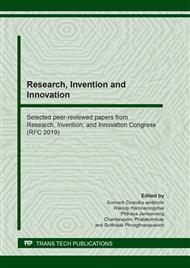p.224
p.230
p.237
p.245
p.253
p.261
p.268
p.276
p.286
Influence of Temperature, Time and Crosslinking Agent on Structure and Properties of Polyurethane Gel
Abstract:
Polyurethane (PU) gel was synthesized based on methylene diphenyl diisocyanate (MDI) and polyols corporation with 1,1,1-Tris(hydroxymethyl)propane (TMP) as a crosslinking agent. The chemical structure of synthesized polyurethane gel was investigated using Fourier-transform infrared spectroscopy (FTIR). The effects of curing temperature, curing time, and crosslinking concentration on the degree of swelling, gel content and hardness of polyurethane gel are investigated. In addition, the crosslink density and average molecular weight between crosslinking points were determined using the Flory-Rehner equation. The results revealed that the curing temperature had more pronounced effect on degree of swelling and gel content than curing time. As the curing temperature increased the degree of swelling and gel content in polyurethane gel increased. Curing time seem to have a complicated effect on crosslink density and average molecular weight between crosslinking points. The hardness of polyurethane gel tends to increase with increasing crosslinking concentration and curing time.
Info:
Periodical:
Pages:
253-260
Citation:
Online since:
August 2020
Keywords:
Price:
Сopyright:
© 2020 Trans Tech Publications Ltd. All Rights Reserved
Share:
Citation:


